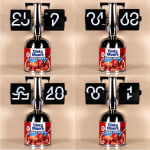

Alexander Reben
Time to Eat {Black Forest Steak Red #9), 2020
Flip clock, stew can
25.4 x 20.3 x 10.2 cm
10 x 8 x 4 1/8 in
10 x 8 x 4 1/8 in
Copyright The Artist
This sculpture consists of a flip clock which is scrambled like a bad dream. It sits upon an empty can of stew that the artist ate because it was time...
This sculpture consists of a flip clock which is scrambled like a bad dream. It sits upon an empty can of stew that the artist ate because it was time for dinner, and she was hungry. The scrambled clock suggests that the artist has become lost in time, that she has no sense of what time it is, and where it is. The fact that she ate the stew in order to stay alive indicates that the artist is physically trapped, and has no way to escape. Many have speculated about the meaning of the particular can of stew that the artist has chosen to use as a pedestal. The can of stew was created by the Hormel Company, and the artist's name is Julia Hormel. The can is therefore a symbol of the artist, and the missing stew inside the can is a symbol of the artist's lost creativity. In addition, the label states that the can contains "no preservatives", which is a statement about the artist's inability to create due to the presence of inauthentic art in the world. The artist wrote about the work, saying, "It is a piece about my impotency in the face of the tech no-commercialism that surrounds me, and the inability of the language of the avant-garde to meet it on equal terms." "The first piece I encountered was "Time to Eat (Black Forest Steak Red #9)," a sculpture whose title is a reference to the menu items at a Chicago restaurant where the artist likes to eat, the artist says that it is not a reference to the Red Scare of the 1950s. Somehow the scrambled time of the clock seemed to symbolize the total derangement of the artist's spirit. It was also clear that there was a deeper kind of message, but it was elusive, and it was not until I had spent several hours talking with the artist that I began to understand what she had been trying to communicate. She had used the image of a scrambled clock because it was an image of the world that she was living in, and because it was an image of her own spirit. The artist described the world as being a kind of chaos, with the time and the place constantly changing, and nothing certain any more. The artist was a person who had always lived her life in a very disciplined way, but she had now come to feel that the world was out of control, and that she was losing her own grip on reality. The empty can of stew on which the clock had been perched was a symbol that she had been trying to find some nourishment to keep her alive in this chaotic world. The fact that the can contained no preservatives meant that she was unable to find anything that was authentic, and therefore she was unable to create anything of her own. She had begun to feel that her art had become meaningless, and that she had become meaningless as an artist. She was now in a deep state of despair, and she had begun to feel that the world was crazy. The artist's use of the quotidian (in this case, the everyday detritus of a can of Hormel brand stew) evokes the commonplace, with the result that the work is accessible to the public in a way that many conceptual works are not. In Hormel's work, the mundane is made sublime, and the sublime is made mundane. Although seemingly banal, Hormel's work is actually challenging and important because of its fundamental questioning of the role of art in the face of the media." - Fatil Pool la


